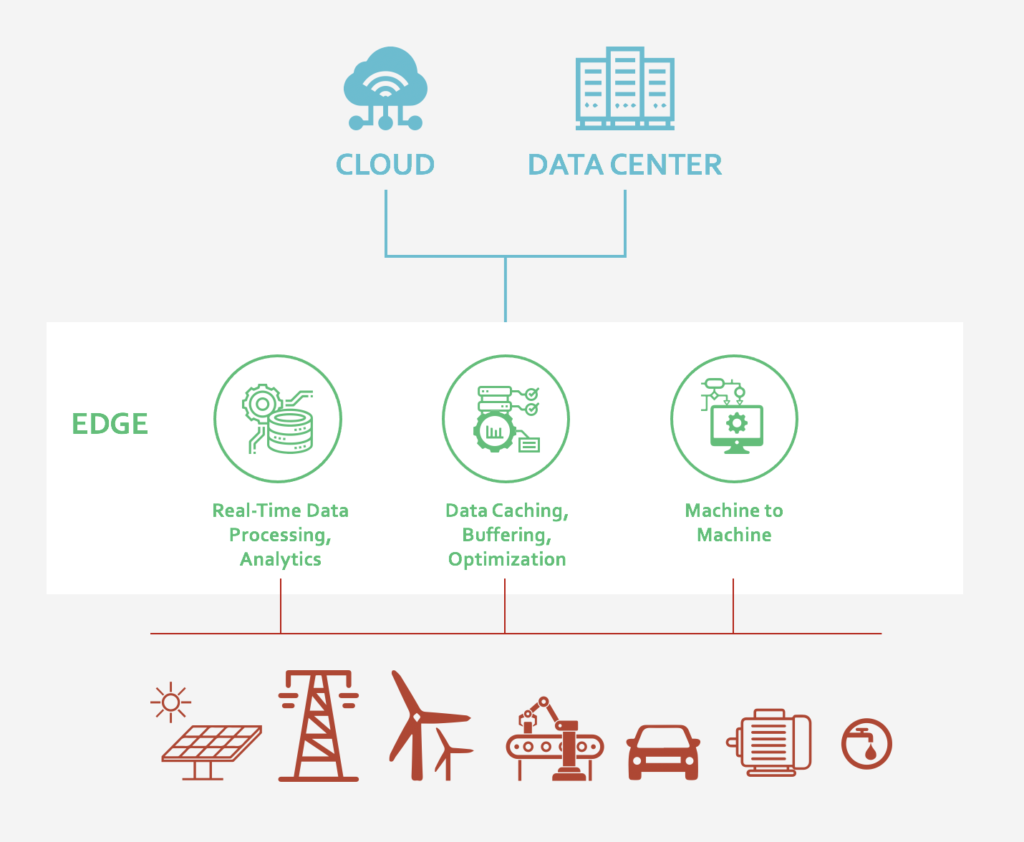IoT vs IIoT
IoT (Internet of Things) refers to “smart” consumer devices connected to the internet — everything from home thermostats and appliances to cars, door locks, and lights. These devices send and receive data, bridging the physical and digital worlds.
IIoT (Industrial Internet of Things) extends the same foundational concept into industrial environments. Both IoT and IIoT rely on connected, intelligent devices at the edge — but the difference lies in use cases and criticality.
- IoT is built for consumer convenience.
- IIoT is built for industrial operations: utilities, manufacturing, energy, supply chain, remote assets, and more.
IIoT is typically part of larger architectures such as SCADA, MES, UNS, and edge computing, and in modern platforms like Tatsoft FrameworX 10.1, IIoT is a core architectural pillar: edge-driven, report-by-exception, lightweight, and open.
Use Cases: IoT vs IIoT
IoT Use Cases
IoT focuses on improving consumer comfort and automation. Examples include:
- Smart appliances that reduce monthly bills
- Devices that automatically turn off lights or adjust HVAC
- Apps that let you monitor or control your home remotely
These devices are convenient, but the consequences of failure are typically low.
IIoT Use Cases
IIoT relies on more advanced industrial devices and edge nodes that deliver real-time visibility, automated control, and scalable analytics. Common examples include:
- Asset tracking and monitoring (the most widespread IIoT use case)
- Automation of manual processes
- Predictive maintenance — the foundation of modern smart factories
- Improving safety and security via video monitoring, remote supervision, and alarms
- Energy efficiency and building automation
- Transitioning from a product model to a services model
- More agile product design, enabled by real operational data
IIoT connects mission-critical machines and sensors in industries like manufacturing, aerospace, defense, healthcare, and energy — where failure can be high-risk or even life-threatening.
In contrast, consumer IoT failures are inconvenient but rarely critical.
Understanding what IIoT is — and how it differs from IoT — helps industrial organizations adopt modern architectures that improve performance, reliability, and scalability.

IIoT Terms
Access Control
Identity verification and permission management for all connected elements — devices, APIs, UIs, data, and users.
Analytics
Analysis of real-time or historical IIoT data. Can include descriptive, predictive, or prescriptive analytics. Platforms like FrameworX 10.1 enable analytics at the edge and in the cloud.
Application
Any logic or service running on or integrated with an IIoT platform — either cloud, on-premises, or at the edge. Applications can expose UIs or run headless.
Data Management
Capabilities to ingest, store, model, manage, and forward IIoT data. In modern platforms, this includes supporting a Unified Namespace (UNS) structure.
Device Management
Lifecycle management for connected devices — onboarding, configuration, firmware updates, and health monitoring.
Event Processing
Rules, alerts, notifications, and automated actions triggered by real-time or stored machine data.
External Integration
Integration of the IIoT platform with third-party systems (ERP, MES, CRM, maintenance, analytics, etc.) through APIs or connectors.
Monitoring
Real-time visibility into device health, alarms, analytics, and data streams, typically using dashboards or operator UIs.
Alerting and Notification
Systems that push messages or events to operators, external systems, or automated workflows.
Authentication and Access Control
Identity verification for all platform elements — devices, APIs, UIs. Includes MFA, multi-tenant support, and encryption.
Data Ingestion and Routing
Ingesting machine data from devices or gateways and routing it through on-platform or off-platform services. Common protocols include MQTT, Sparkplug B, HTTP, OPC UA, and more.
Device
Any hardware/software combination delivering an IIoT function.
Device Connectivity
Communication paths between devices and gateways using BLE, Zigbee/Z-Wave, LAN, LPWAN, cellular, satellite, or fixed networks.
Device Metadata Storage
A datastore containing device metadata, configuration, state, and history — often SQL or NoSQL.
Edge Capabilities
Edge Analytics
Local analytics performed at the edge — from anomaly detection to metrics, logic, or ML inference.
Edge Data Normalization
Standardizing raw machine data into structured formats for northbound publication (UNS, MQTT, Sparkplug B, SQL).
Edge Data Storage
Temporary or persistent storage at the edge, enabling buffering, offline operation, or local analytics.
Edge IIoT Application
An IIoT application running directly on the edge, interfacing with local devices and APIs.
Edge Event Processing
Rules, alerts, or logic executed locally at the edge rather than in the cloud or server.
Edge-to-Cloud Connectivity
Communication between devices/gateways and cloud or on-prem IIoT platforms via LPWAN, cellular, satellite, or other networks.
Core IIoT Concepts
Enterprise Application
External systems (ERP, CRM, CMMS, MES, UNS, analytics) that interface with the IIoT platform.
Event Processing (Historical)
Actions triggered from previously stored data — predictive analytics, anomaly detection, or threshold rules.
Event Processing (Real-Time)
Immediate actions based on live data streams — alarms, callouts, workflows.
External Integration
Bidirectional exchange of data between an IIoT platform and external systems via APIs or connectors.
IIoT Application
Logic running on or integrated with the IIoT platform, with or without a UI, controlling or analyzing device data.
Machine Data Storage
Time-series or NoSQL storage for IIoT data, enabling queries by device, time window, or asset type.
Northbound Data APIs
APIs allowing access to stored or real-time machine data for enterprise applications.
On-Platform Analytics
Analytics performed directly inside the IIoT platform, often integrated into dashboards or workflows.
Operator UI
Interfaces used for day-to-day IIoT operations — device status, alarms, analytics, dashboards.
Protocol Adapter
A gateway service converting industrial protocols (Modbus, Rockwell, Siemens, etc.) into standard protocols like MQTT/Sparkplug B.
Southbound Data APIs
APIs that enable communication from the platform back to field devices or gateways.
